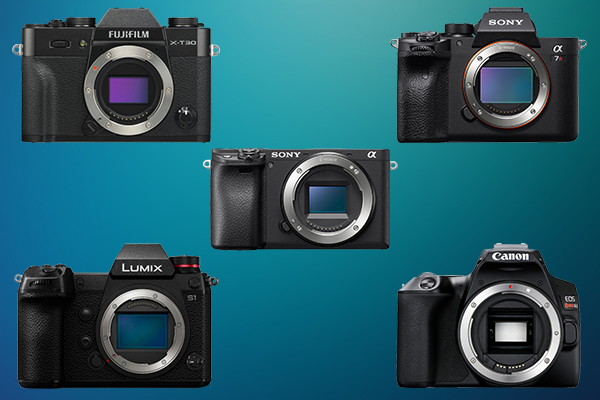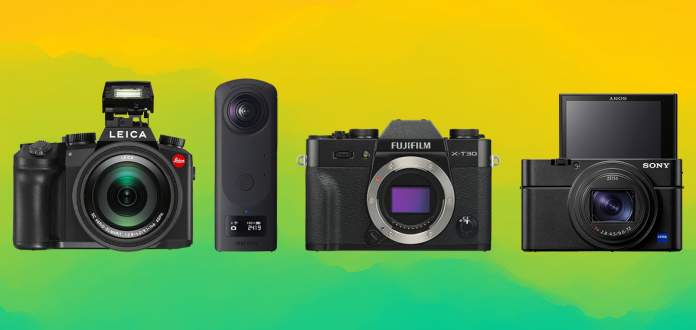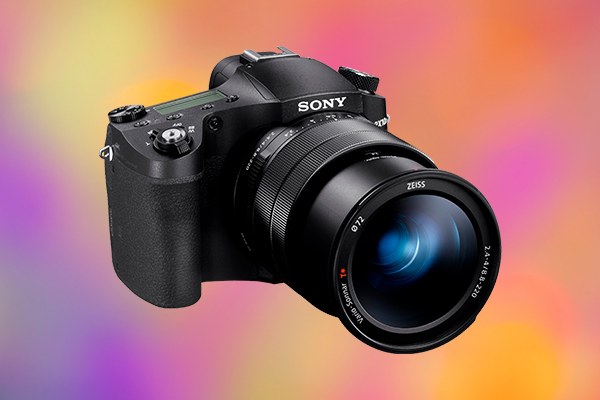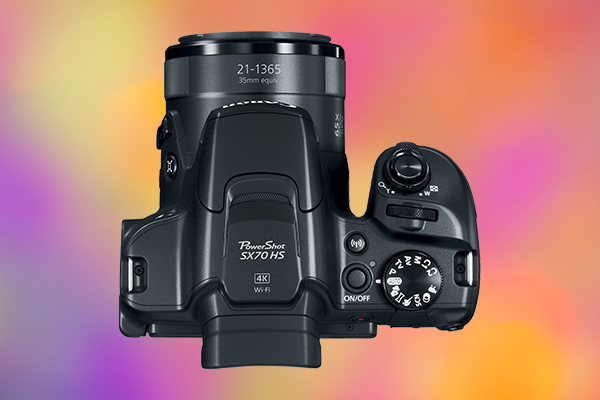The toughest part of vacation prep is choosing which camera gear is worthy of your carry-on space. We put together this roundup to help you make an informed decision before your next big trip. Below are the best travel cameras of 2019 including point-and-shoots, bridge cameras, interchangeable lens cameras, and action/adventure cams.
With very few exceptions (one or two late December 2018 releases), every one of these devices was released within this calendar year. Scroll down to find the latest and greatest gear and be sure to comment with any questions or additional suggestions.
Point-And-Shoot | Best Travel Cameras 2019

- Pros:
- Point-and-shoot cameras are the lightest option on our list making them a great choice for travel.
- Their minimal weight goes hand-in-hand with their small size. Point-and-shoots easily fit into pockets, backpacks, and purses.
- Point-and-shoots are a one-device solution. There’s no need to lug around multiple lenses or accessories in addition to a camera body.
- Cons:
- You are locked into one lens. This limits your ability to get the specific shots you want.
- A smaller body means a smaller sensor and lower image quality.
- Point-and-shoots give you a decent amount of control over manual settings. However, you have more control over granular changes with an interchangeable lens camera or some bridge cameras.

1. Sony Cyber-shot RX100 VII
- Highlights:
- Optical SteadyShot image stabilization
- World’s fastest (0.02 sec.) hybrid AF system
- Retractable XGA OLED Tru-Finder EVF
- Specs:
- Sensor: 20.1MP 1″ Exmor RS stacked C, LG instant HDR
- Image Processor: BIONZ X
- Video: 4K movie with direct pixel readout and HLG instant HDR
- Zoom: 8x
- Screen: Multi-angle LCD
- Lens: 24-200mm F2.8 – F4.5 ZEISS Vario-Sonnar T* lens
2. Canon PowerShot G7 X Mark III
- Highlights:
- Live streaming capable/vertical video support
- External microphone support, clean HDMI output
- Selfie-ready tilting screen
- Specs:
- Sensor: 20.1MP 1-in stacked CMOS
- Image Processor: DIGIC 8
- Video: 4K
- Zoom: 4.2x
- Screen: Multi-angle LCD
- Lens: 24-100mm-equivalent f/1.8-2.8 lens
To learn more about the Canon PowerShot G7 X, check out our guide of the best point-and-shoot cameras of 2019 here.
3. Ricoh GR III
- Highlights:
- Shake reduction at slow shutter speeds up to 1/4 second
- Programmable controls and rearranged keys
- Fast, precise autofocus
- Specs:
- Sensor: 24.23 MP APS-C
- Image Processor: RICOH GR Engine 6
- Video: Full HD
- Zoom: N/A
- Screen: Fixed LCD
- Lens: 28mm f/2.8 Lens
To learn more about the Ricoh GR III, read our full review here.
4. Leica Q2 Digital Camera
- Highlights:
- Shake reduction at slow shutter speeds up to 1/4 second
- Compact, fully weather-sealed body
- Incredibly fast autofocus
- Specs:
- Sensor: 47.3 MP Full-Frame Sensor
- Image Processor: Leica Maestro II
- Video: 4K with UHD and Cine4K
- Zoom: N/A
- Screen: Fixed LCD
- Lens: Fixed Prime Summilux 28mm f/1.7 ASPH
Interested to see how the original Leica Q stands up to the new Leica Q2? Check out our full comparison here.
Bridge Cameras | Best Travel Cameras 2019

- Pros:
- Like point-and-shoots, bridge cameras are a one-device solution. There’s no need to lug around multiple lenses or accessories in addition to a camera body.
- Bridge cameras have consistently strong zoom.
- You can bring them into most concerts and festivals without issue. Many venues don’t allow people to enter the concert area with “professional” removable-lens cameras.
- Cons:
- Bridge cameras’ built-in lenses limit your flexibility and shooting capabilities.
- They’re bulkier than a point-and-shoot.
- There’s no room to grow and advance with a bridge camera. It has set capabilities that you must work within.

1. Sony Cyber-Shot RX10 IV
- Highlights:
- 24 fps continuous shooting with full AF/AE tracking
- Optical SteadyShot™ image stabilization
- World’s fastest AF acquisition speed of 0.03 seconds
- Specs:
- Sensor: 20.1MP Exmor RS Stacked CMOS
- Video: 4K movie recording capable with full pixel readout
- Zoom: 25x
- Screen: Multi-angle LCD
- Lens: ZEISS Vario-Sonnar T* 24-600mm f/2.4-f/4 large aperture lens
2. Leica V-Lux 5
- Highlights:
- Post-Focus and Focus Stacking modes
- Wi-Fi and Bluetooth connectivity with Leica FOTOS
- Micro-USB battery charging port
- Specs:
- Sensor: 20MP CMOS
- Video: UHD 4K video
- Zoom: 16x
- Screen: Articulating LCD
- Lens: 9.1-146mm (25-400mm equivalent) f/2.8-4 ASPH lens
3. Panasonic Lumix FZ1000 II
- Highlights:
- Post Focus and Focus Stacking modes
- Auto marking and sequence composition functions
- Approximately 12fps continuous shooting
- Specs:
- Sensor: 20.1MP 1″ high sensitivity CMOS
- Video: 4K 30p video
- Zoom: 16x
- Screen: Articulating LCD
- Lens: 25-400mm F2.8-4.0
Learn more about the FZ1000 II in our detailed comparison post here: Panasonic Lumix FZ1000 II vs Lumix FZ1000 (Comparison Chart)
4. Nikon Coolpix B600
- Highlights:
- Superior lens shift vibration reduction
- Snap-back zoom button to aid in the detection of moving subjects
- 19 Scene modes
- Specs:
- Sensor: 16MP
- Video: Full HD 1080p
- Zoom: 60x
- Screen: Fixed
- Lens: 24-1440mm F3.3-6.5 lens
5. Canon PowerShot SX70
- Highlights:
- 5-stop Optical Image Stabilization
- Zoom Framing Assist
- Continuous Shooting of up to 10 fps
- Specs:
- Sensor: 20.3 Megapixel CMOS
- Video: 4K UHD Video
- Zoom: 65x
- Screen: Multi-angle LCD
- Lens: 21-1365mm (equiv.) f/3.4-6.5 lens
Interchangeable Lens Cameras | Best Travel Cameras 2019

- Pros:
- Interchangeable lens cameras are favored by professional photographers. As a result, they provide greater control over granular settings than bridge cameras or point-and-shoots.
- The option for different lenses and accessories allows you to capture the exact shot you want without compromise.
- Interchangeable lens cameras give photographers more room to grow. As you gain confidence behind the camera, you can buy additional lenses or a new, better body.
- Cons:
- More gear means less space. Interchangeable lens cameras and their lenses are bulky and can be difficult to store.
- You can technically carry one lens. But, if you’re shooting in varied conditions/environments you will need to carry and switch out multiple lenses. Alternatively, bridge cameras are designed to combine the capabilities of 2-3 lenses in one.
- The body, lenses, and accessories make interchangeable lens cameras significantly more expensive than their counterparts.

1. Sony Alpha a6400
- Highlights:
- 425-point AF
- Continuous shooting of up to 11 fps
- Instant sharing via smartphone with Wi-Fi and NFC
- Specs:
- Sensor: 24.2MP APS-C Exmor sensor
- Image Processor: BIONZ X
- Video: Ultra HD 4K video
- Screen: Tiltable LCD display
- Lens Mount: E-mount
Do you need help picking a lens? Check out our roundup of the top 5 best lenses for the Sony a6400 here: The 5 Best Lenses For The Sony a6400 | Sample Photos.
2. Fujifilm X-T30
- Highlights:
- Built-in Wi-Fi and Bluetooth 4.2, SD card slot
- Accurate autofocus tracking and face detection
- Intuitive design with comfortable controls
- Specs:
- Sensor: 26.1MP APS-C X-Trans CMOS 4
- Image Processor: X-Processor 4 Quad-Core CPU
- Video: 4K video at 30 fps
- Screen: Tiltable LCD display
- Lens Mount: X-mount
3. Canon EOS SL3
- Highlights:
- OVF with a 9-point AF system
- ISO 100-25600
- 5-axis image stabilization
- Specs:
- Sensor: 24.1MP APS-C CMOS
- Image Processor: DIGIC 8
- Video: 4K video with up to 24p frame rate
- Screen: Vari-angle touchscreen LCD
- Lens Mount: EF/EF-S
4. Sony Alpha a7R IV
- Highlights:
- In-body 5-axis image stabilization
- Up to 10 fps with AF/AE tracking
- High-speed Wi-Fi / FTP transfer and wireless PC remote
- Specs:
- Sensor: 61MP full-frame Exmor R
- Image Processor: BIONZ X
- Video: 4K HDR
- Screen: Tiltable LCD display
- Lens Mount: A-mount
This camera is the follow up to the popular a7R III. We did a full comparison of both cameras which you can find here: Sony Alpha a7R IV vs a7R III – Specs & Photos (Comparison Chart).
5. Panasonic Lumix S1
- Highlights:
- Built-in body image stabilizer
- Dual SD UHS-II / XQD memory card slots
- Advanced AF system with DFD technology
- Specs:
- Sensor: 24.2MP full-frame CMOS
- Image Processor: Venus Engine image processor
- Video: 4K 60p/50p video recording
- Screen: 5,760k-dot OLED eye viewfinder
- Lens Mount: L-mount
Check out our full review of the Lumix S1 here: Panasonic Lumix S1 vs S1R (Comparison Chart).
Action Cameras | Best Travel Cameras 2019
These are specialized cameras that fill individual needs. As a result, we can’t give an accurate overview of this group’s pros and cons. Scroll to see the benefits of each model.


1. Olympus Tough TG-6
- Highlights:
- This camera is waterproof, crushproof, shockproof, freezeproof and dustproof.
- It features ultra HD 4K and Full HD 120 fps high-speed video recording for dramatic adventure moments.
- The Olympus Tough TG-6 has a built-in GPS system, compass, thermometer sensor, and manometer/barometer.
- Specs
- Type: rugged adventure camera
- Sensor: 12 Megapixel BSI CMOS
- Video: 4K 30p
- Zoom: 4x
- Screen: 3-inch, 1040k-dot fixed LCD
- Lens: Optical zoom lens (25-100mm equivalent), f/2.0-4.9
2. Ricoh Theta Z1
- Highlights:
- This is the first Theta camera to support RAW DNG capture.
- The Z1 features image stabilization.
- This camera supports 360º HD live streaming.
- Specs
- Type: 360° Camera
- Sensor: Two 1-inch BSI-CMOS sensors, 20mp each
- Video: 3840 x 1920 @ 29.97fps
- Zoom: N/A
- Screen: status monitor
- Lens: Optical zoom lens (25-100mm equivalent) f/2.0-4.9
We created a comparison chart of every Ricoh Theta camera ever made. You can find it here: Every Ricoh THETA Camera From The M15 to Z1 (Comparison Chart)
3. DJI Osmo Action
- Highlights:
- RockSteady stabilization technology
- Custom exposure settings
- Waterproof up to 11 meters
- Dual front-facing and back-facing screens
- Specs
- Type: Rugged action camera
- Sensor: 12MP 1/2.3” sensor
- Video: 4K videos up to 24fps
- Zoom: N/A
- Screen: switchable, dual-LCD screens
- Lens: 145° field of view, f/2.8
4. DJI Osmo Pocket
- Highlights:
- Lossless mechanical stabilization
- DJI’s smallest 3-axis mechanical handheld gimbal
- Multiple shooting modes including Motion Lapse, NightShot, ActiveTrack, and 3×3 Panorama
- Specs
- Type: pocket gimbal
- Sensor: 12 MP 1/2.3-inch sensor
- Video: 4K/60fps video at 100 Mbps
- Zoom: N/A
- Screen: built-in, fixed touchscreen
- Lens: 80° FOV, f/2.0
You can find our first look at the DJI Osmo Pocket here: First Look: The DJI OSMO Pocket Camera
That concludes our roundup of the 18 Best Travel Cameras of 2019. Leave questions and suggestions in the comments below.





























































































































